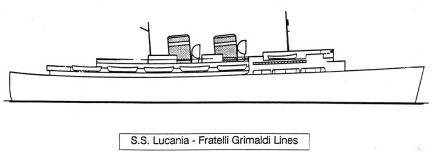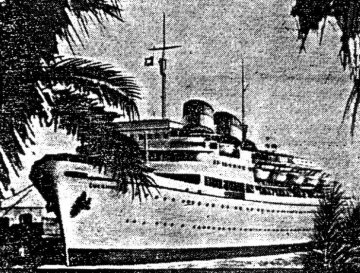
HILLMAN WWII SCRAPBOOK
HMCS PRINCE ROBERT
Presents
8. S.S. LUCANIA 1952



The ROBERT was too good a ship to scrap since her machinery and hull had been found in excellent condition on her last refit barely half a year previously. She was towed to Lynn Creek, where War Assets Corporation showed her to prospective buyers with a price tag of $500,000. The first vulture hovering about had a paternal air. One would have thought the C.N.S.S. would have been happy to unload their white elephants onto the Navy even at a loss of $1.5 million per ship. Perhaps the feeling was that with so much money already down the drain, they could not possibly lose more. But here again was the CNR applying to get its ships back.The Navy gave them the run-around. The CNR President wrote to the Minister of Defence who referred him to War Assets who sent him to the Deputy Minister of Naval Services, who said that COPC was the man to see. Eventually the red-tape curtain was parted and the CNR got a chance to survey the ship which had been both their prewar pride and despair.
The re-purchasing agent apparently did not like what he saw. The ROBERT and HENRY stayed in their display cases until September of 1946. At this time, they were sold for the asking price to the Charlton Steam Shipping Company Ltd. of London, a subsidiary of the Greek Chandris concern. They steamed to England under their own power, where passenger accommodation of a sort was restored although not on a very grand scale. The ROBERT sailed again under the name CHARLTON SOVEREIGN, running from the U.K. to Australia, thus enjoying a wide-ranging freedom of the seas which she had helped secure.
Once again, the ex-PRINCE ROBERT changed hands in April of 1952 for a price of $1,367000 when she was sold to the Fratelli Grimaldi Line of Genoa (Sicula Oceanica). This was at a price almost twice what she had cost the RCN twelve years and one war earlier.
The hull was gutted, the ship cut in half and some 50 feet added to its length. The main deck was extended to the stern and three decks added where there had been only tow in the 1930 configuration. This operation had the effect of not only increasing her passenger capacity but added the speed and maneuverability as well. She sailed under the name LUCANIA on the Italy-South America run.
The hull and superstructure were now a gleaming white and the two funnels were blue with a white band. First class and tourist passengers were carried and amenities such as tiled outdoor swimming pools, a children’s pool, lounges and ballrooms decorated in elaborate modern Italian style were provided. It was truly a reincarnation of the grandeur Sir Henry Thornton had envisaged for this fine ship in 1930. She achieved the success which had been denied her in her earlier life.
She sailed from Genoa to Venezuela via Barcelona, the Canary Islands and Curacao, returning by way of Havana, Miami, Bermuda and the Azores. Finally the jet traffic spelled the end of the transatlantic passenger ship era. In 1962 this fine ship arrived at Spezia, Italy to be scrapped. Her sister ship, the HENRY, had arrived at the same port for the same fate one week earlier. Thus the ROBERT was the last and the most noteworthy survivor of the “Three Princes.”
Few ships have had such a varied and successful career and the ROBERT will long be remembered with fondness, as will her shipmates, by those who sailed in her.

S.S. Lucania 1952



Webmaster: William G. Hillman
BILL & SUE-ON HILLMAN ECLECTIC STUDIO
Copyright 2000/2006/2017
Bill Johnson Material Copyright 1988